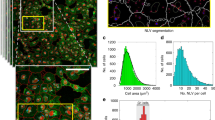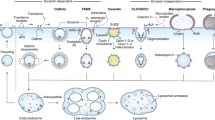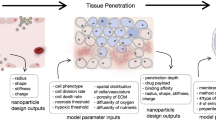Abstract
The delivery of nanoparticles into cells is important in therapeutic applications1,2,3 and in nanotoxicology4. Nanoparticles are generally targeted to receptors on the surfaces of cells and internalized into endosomes by endocytosis5,6,7,8,9, but the kinetics of the process and the way in which cell division redistributes the particles remain unclear. Here we show that the chance of success or failure of nanoparticle uptake and inheritance is random. Statistical analysis of nanoparticle-loaded endosomes indicates that particle capture is described by an over-dispersed Poisson probability distribution that is consistent with heterogeneous adsorption and internalization. Partitioning of nanoparticles in cell division is random and asymmetric, following a binomial distribution with mean probability of 0.52–0.72. These results show that cellular targeting of nanoparticles is inherently imprecise due to the randomness of nature at the molecular scale, and the statistical framework offers a way to predict nanoparticle dosage for therapy and for the study of nanotoxins.
This is a preview of subscription content, access via your institution
Access options
Subscribe to this journal
Receive 12 print issues and online access
$259.00 per year
only $21.58 per issue
Buy this article
- Purchase on Springer Link
- Instant access to full article PDF
Prices may be subject to local taxes which are calculated during checkout




Similar content being viewed by others
References
Scheinberg, D. A., Villa, C. H., Escorcia, F. E. & McDevitt, M. R. Conscripts of the infinite armada: systematic cancer therapy using nanomaterials. Nature Rev. Clin. Oncol. 7, 266–276 (2010).
Ferrari, M. Cancer nanotechnology: opportunities and challenges. Nature Rev. Cancer 5, 161–171 (2005).
Koo, O. M., Rubinstein, I & Onyuksel, H. Role of nanotechnology in targeted drug delivery and imaging: a concise review. Nanomedicine 1, 193–212 (2005).
Teeguarden, J. G., Hinderliter, P. M., Orr, G., Thrall B. D. & Pounds, J. G. Particokinetics in vitro; dosimetry considerations for in vitro nanoparticle toxicity assessments. Toxicol. Sci. 95, 300–312 (2007).
Zhang, S., Li, J., Lykotrafitis, G., Bao, G. & Suresh, S. Size-dependent endocytosis of nanoparticles. Adv. Mat. 20, 1–6 (2008).
Kim, J.-S. et al. Cellular uptake of magnetic nanoparticle is mediated through energy-dependent endocytosis in A549 cells. J. Vet. Sci. 7, 321–326 (2006).
Chithrani, B. D., Ghazani, A. A. & Chan, W. C. W. Determining the size and shape dependence of gold nanoparticle uptake into mammalian cells. Nano Lett. 6, 662–668 (2006).
Osaki, F., Kanamori, T., Sando, S., Sera, T. & Aoyama, Y. A quantum dot conjugated sugar ball and its cellular uptake. On the size effects of endocytosis in the subviral region. J. Am. Chem. Soc. 126, 6520–6521 (2004).
Gratton, S. E. A. et al. The effect of particle design on cellular internalization pathways. Proc. Natl Acad. Sci. USA 105, 11613–11618 (2008).
Rajendran, L., Knőlker, H.-J. & Simons, K. Subcellular targeting strategies for drug design and delivery. Nature Rev. Drug Discov. 9, 29–42 (2010).
Feazell, R. P., Nakayama-Ratchford, N., Dai, H. & Lippard, S. J. Soluble single-walled carbon nanotubes as longboat delivery systems for platinum(IV) anticancer drug design. J. Am. Chem. Soc. 129, 8438–8439 (2007).
Na, H. B. et al. Development of a T1 contrast agent for magnetic resonance imaging using MnO nanoparticles. Angew. Chem. Int. Ed. 46, 5397–5401 (2007).
Jaiswal, J. K., Mattoussi, H., Mauro, J. M. & Simon, S. M. Long-term multiple color imaging of live cells using quantum dot bioconjugates. Nature Biotechnol. 21, 47–51 (2003).
Åkerman, M. E., Chan, W. C. W., Laakkonen, P., Bhatia, S. N. & Ruoslahtl, E. Nanocrystal targeting in vivo. Proc. Natl Acad. Sci. USA 99, 12617–12621 (2002).
Brown, M. S. & Goldstein, J. L. Receptor-mediated endocytosis: insights from the lipoprotein receptor system. Proc. Natl Acad. Sci. USA 76, 3330–3337 (1979).
Conner, S. D. & Schmid, S. L. Regulated portals of entry into the cell. Nature 422, 37–44 (2003).
Decuzzi, P. & Ferrari, M. The receptor-mediated endocytosis of nonspherical particles. Biophys. J. 94, 3790–3797 (2008).
Sun, Y. H. et al. Photostability and pH sensitivity of CdSe/ZnSe/ZnS quantum dots in living cells. Nanotechnology 17, 4469–4476 (2006).
Errington, R. J. et al. Single cell nanoparticle tracking to model cell cycle dynamics and compartmental inheritance. Cell Cycle 9, 121–130 (2010).
Ehrlich, M. et al. Endocytosis by random initiation and stabilization of clathrin-coated pits. Cell 118, 591–605 (2004).
Bergeland, T., Widerberg, J., Bakke, O. & Nordeng, T. W. Mitotic partitioning of endosomes and lysosomes. Curr. Biol. 11, 644–651 (2001).
Quenouille, M. H. A relation between the logarithmic, Poisson and negative bionomial series. Biometrics 5, 162–164 (1949).
Kato, H. et al. Dispersion characteristics of various metal oxide secondary nanoparticles in culture medium for in vitro toxicology assessment. Toxicol. in vitro 24, 1009–1018 (2010).
Balaji, J. & Ryan, T. A. Single-vesicle imaging reveals that synaptic vesicle exocytosis and endocytosis are coupled by a single stochastic mode. Proc. Natl Acad. Sci. USA 104, 20576–20581 (2007).
Rajan, S. S. & Vu, T. Q. Quantum dots monitor TrkA receptor dynamics in the interior of neural PC12 cells. Nano Lett. 6, 2049–2059 (2006).
Lehnert, B. E. et al. Mechansims underlying the redistribution of particles among the lung's alveolar macrophages during alveolar phase clearance. Ann. Occup. Hyg. 38, 215–224 (1994).
Dunster, K., Toh, B. H. & Sentry, J. W. Early endosomes, late endosomes, and lysosomes display distinct partitioning strategies of inheritance with similarities to Golgi-derived membranes. Eur. J. Cell. Biol. 81, 117–124 (2002).
Macara, I. G. & Mili, S. Polarity and differential inheritance—universal attributes of life? Cell 135, 801–812 (2008).
Rujano, M. A. et al. Polarised asymmetric inheritance of accumulated protein damage in higher eukaryotes. PLoS Biol. 4, 2325–2335 (2006).
Singhvi, A. & Garriga, G. Asymmetric divisions, aggresomes and apoptosis. Trends Cell Biol. 19, 1–7 (2008).
Jones, A. T. Gateways and tools for drug delivery: Endocytic pathways and the cellular dynamics of cell penetrating peptides. Int. J. Pharmacol. 354, 34–38 (2008).
Nauman, D. A. & Bertozzi, C. R. Kinetic parameters for small-molecule drug delivery by covalent cell surface targeting. Biochim. Biophys. Acta 1568, 147–154 (2001).
Acknowledgements
The authors thank N. Hondow and A. Brown for the electron micrograph of quantum dots and P. Williams for the DLS data. This work was supported by the Engineering and Physical Sciences Research Council, UK (grant no. EP/H008683/1, ‘Nanoparticle Cytometrics’) and the European Regional Development Funded Swansea Centre for Nanohealth.
Author information
Authors and Affiliations
Contributions
H.D.S., P.R., R.J.E. and P.J.S. designed the experiments. H.D.S., P.R. and M.R.B. analysed the data. H.D.S. and P.R. wrote the manuscript in close collaboration with the other authors. M.D.H and S.C. performed cell culture and nanoparticle loading. M.D.H. performed flow cytometry measurements. All authors discussed the results and approved the final version of the manuscript.
Corresponding author
Ethics declarations
Competing interests
The authors declare no competing financial interests.
Supplementary information
Supplementary information
Supplementary information (PDF 1529 kb)
Supplementary information
Supplementary movie (AVI 2709 kb)
Supplementary information
Supplementary information (PDF 314 kb)
Rights and permissions
About this article
Cite this article
Summers, H., Rees, P., Holton, M. et al. Statistical analysis of nanoparticle dosing in a dynamic cellular system. Nature Nanotech 6, 170–174 (2011). https://doi.org/10.1038/nnano.2010.277
Received:
Accepted:
Published:
Issue Date:
DOI: https://doi.org/10.1038/nnano.2010.277
This article is cited by
-
Molecular bottlebrush prodrugs as mono- and triplex combination therapies for multiple myeloma
Nature Nanotechnology (2023)
-
Imaging flow cytometry
Nature Reviews Methods Primers (2022)
-
The origin of heterogeneous nanoparticle uptake by cells
Nature Communications (2019)
-
Tracking the Evolution of Transiently Transfected Individual Cells in a Microfluidic Platform
Scientific Reports (2018)
-
Reply to 'The interface of nanoparticles with proliferating mammalian cells'
Nature Nanotechnology (2017)



